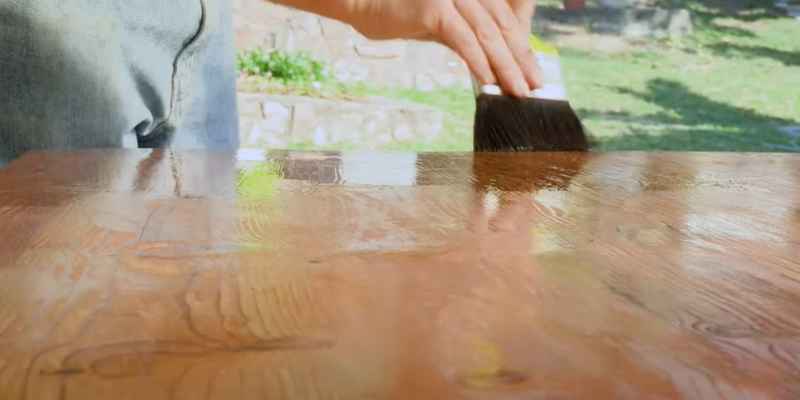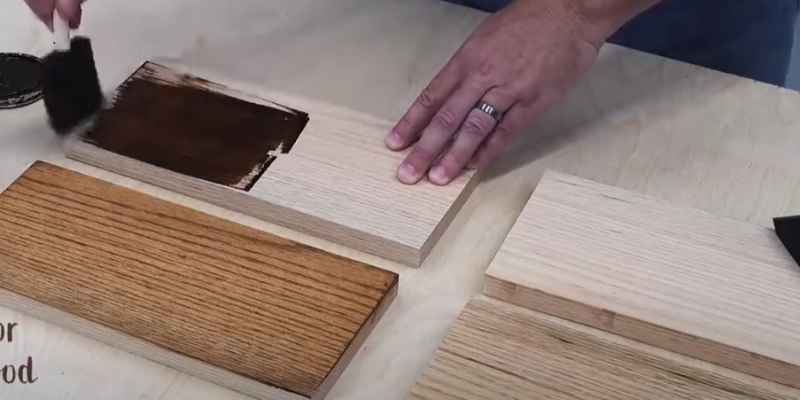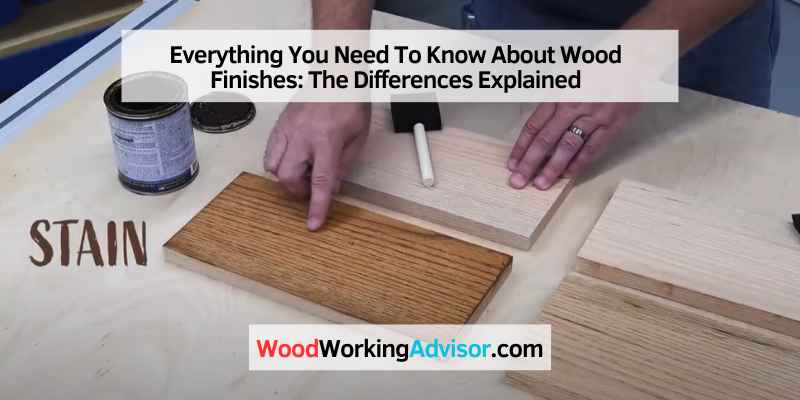There are many different types of wood finishes available on the market today. The most common and popular finishes are lacquer, varnish, shellac, oil-based polyurethane, and water-based polyurethane. Each type of finish has unique properties that suit specific applications best.
This article will discuss the differences between these five most common wood finishes.
There are many different types of wood finishes available on the market today. Each type of finish has its unique properties and benefits. Choosing the right finish for your project can be daunting, but selecting the finish that will best protect your investment and provide the desired look is essential.
The most common wood finishes are lacquer, shellac, varnish, polyurethane, and oil. Lacquer is a clear or colored coating that dries quickly and provides a durable finish. Shellac is an alcohol-based resin that gives the wood a warm amber color and protects against moisture.
Varnish is a resin-based finish that comes in both water-based and oil-based formulas. Polyurethane is a synthetic polymer that dries to a hard, durable finish. Oil finishes penetrate the wood grain and protect it from within.
When selecting a wood finish, it is essential to consider the project environment and the desired final appearance. For example, lacquer is not recommended for outdoor use because it does not stand up well to UV exposure. Likewise, shellac should not be used on surfaces that come into contact with food or water because it can dissolve in these liquids.
Varnish and polyurethane are good choices for kitchen cabinets or other areas where durability and moisture resistance are vital concerns. Oil finishes are typically used on floors or other high-traffic areas because they provide excellent wear resistance.

Difference between Wood Stain And Wood Finish
Most people don’t know the difference between wood stain and wood finish. Here’s a quick explanation: Wood stain is a thin, translucent coating that allows the wood’s natural grain to show through.
It does not provide any protection against wear and tear. Wood finish is a thicker, opaque coating that protects against wear and tear. It can be applied over stained or unstained wood.
Polyurethane Wood Finish
Polyurethane is one of the most durable finishes for wood floors, but it can be tricky to apply.
Here are some tips for getting a smooth, even finish:
1. Start with a clean, dust-free surface. Polyurethane won’t adhere well to dirt or dust, so ensure your floor is clean before you start.
2. Use a good-quality brush or roller designed for polyurethane. Cheap brushes will shed bristles and leave streaks in the finish.
3. Apply thin coats of polyurethane, letting each coat dry completely before adding the next. Thick skins are more likely to bubble and create an uneven finish.
4. Be careful not to over-apply polyurethane around edges and corners where it’s easy to build up too much product.
Thin out thick areas with mineral spirits if necessary.
5. Sand lightly between coats with fine-grit sandpaper (320 or higher) to create an ultra-smooth finish.
Lacquer Vs. Varnish
Regarding finishes for woodworking projects, there are two main options: lacquer and varnish. Both have unique benefits and drawbacks, so choosing the right one for your project is essential. Here’s a quick overview of the differences between lacquer and varnish:
Lacquer is a thinner finish that dries quickly, making it ideal for projects that must be completed promptly. However, it’s not as durable as varnish and can be susceptible to scratches and nicks. Varnish is a thicker finish that takes longer to dry but is much more durable than lacquer.
It’s also less likely to show imperfections in the wood surface beneath it.
Wood Varnish
Wood varnish is a clear, hard finish typically used to protect wood surfaces from wear and tear. It is usually made from a blend of natural resins and oils and can be applied using a brush, sprayer, or cloth. Varnish is available in water- and oil-based formulations, each with its advantages and disadvantages.
Water-based varnishes are easier to apply and clean up, but they don’t provide as much protection as oil-based varnishes. Oil-based varnishes take longer to dry and can be more challenging to work with, but they offer superior durability. No matter which type of varnish you choose, it’s essential to follow the manufacturer’s instructions carefully to ensure the best results.
In general, you’ll want to sand the surface smooth before applying varnish; start with a thin coat, and build up to thicker coats as needed. With proper care, a good coat of wood varnish can last many years.
Wood Finishing Techniques
Wood finishing is the process of protecting and enhancing the beauty of wood. Many different techniques can be used to achieve various looks, from natural and rustic to sleek and modern. The type of finish you choose will depend on the project you’re working on and your personal preference.
Here are some of the most popular wood finishing techniques: Staining: This is a popular technique for bringing out the natural grain pattern in the wood. Stains come in various colors, so you can choose one that complements the rest of your décor.
Painting: Paint is another great way to add color to wood surfaces. You can use it to create contrast or coordinate with other elements in the room. Just sand and prime the surface first for the best results.
Gluing: If you’re working with small pieces of wood, you may need to glue them together before applying a finish. This technique is also helpful in repairing damage or filling gaps. Varnishing: Varnish is a clear coating that helps protect the wood from moisture and wear and tear.
It also gives surfaces a nice shine. Polyurethane is another option for protecting finishes against damage while still allowing the beauty of the wood grain to show through.
Shellac Wood
Shellac is a natural resin that is secreted by the lac bug. It has been used for centuries as a wood finish and sealant. Shellac is made by dissolving flakes of shellac in alcohol.
The resulting mixture can be applied to wood with a brush or cloth. Shellac provides a hard, durable finish that resists moisture and staining. It also enhances the beauty of the wood grain.
Shellac is available in clear and amber shades. It can be buffed to a high sheen or left matte. Shellac is an easy-to-use finish that dries quickly.
It does not require any special equipment or skills to apply. Shellac is ideal for finishing furniture, cabinets, and trim work.
Lacquer Vs. Shellac
Lacquer and shellac are two types of finishes often used on wood. Both have unique properties and benefits, so choosing the right one for your project is essential. Here’s a quick rundown of the differences between lacquer and shellac:
Lacquer is a durable finish that can withstand plenty of wear and tear. It’s also resistant to moisture, so it’s a good choice for surfaces that might come into contact with water or other liquids. On the other hand, Shellac is not as durable as lacquer and can be easily damaged by water.
However, it dries much faster than lacquer and doesn’t require any special equipment to apply. So, which should you choose? It depends on what you need the finish to do.
If you need a tough, durable finish that can handle a lot of abuse, go with lacquer. If you need a fast-drying finish that is easy to apply, shellac is the way.
What are the Different Types of Wood Finishing?
There are a few different types of wood finishing that you can do to your furniture. The most common type is staining when you use a dark-colored liquid to change the color of the wood. You can also paint wood, giving it a completely different look.
Another option is to varnish the wood, protecting it from water damage and making it shine.
What are 3 Different Wood Finishes?
There are three main wood finishes: lacquer, shellac, and varnish. Each has unique benefits and drawbacks that make it better suited for specific projects than others. Lacquer is a clear finish that dries quickly and provides a high level of protection against moisture and abrasion.
It is also one of the most durable finishes, making it ideal for pieces that will see heavy use. The main downside to lacquer is that it can be challenging to repair if it becomes damaged. Shellac is another clear finish, but it dries more slowly than paint and does not provide as much protection.
However, shellac is much easier to repair than lacquer, making it a good choice for projects where damage is likely to occur. Shellac also has a lovely natural sheen that many prefer over the high gloss of lacquer. Varnish is a thicker finish that takes longer to dry but provides an even higher level of protection against moisture and wear.
Varnish can also be buffed to create a glossy finish, although this isn’t always desirable for furniture pieces. The main downside to varnish is that it tends to yellow over time, so it’s not the best choice for light-colored woods.
What is the Best Type of Finish for Wood?
There are a few different types of finishes that can be used on wood, and the best finish for your project will depend on the type of wood you are using, the look you are going for, and the level of protection you need. Some standard finishes for wood include varnish, shellac, lacquer, and oil. Varnish is a durable finish available in water- and oil-based formulas.
It is easy to apply and can be buffed to a high shine. Varnish is typically used on furniture and cabinets. Shellac is a resin secreted by the female lac bug.
It dries quickly and forms a hard, durable film. Shellac can be applied with a brush or sprayed on and buffed to a high gloss finish. Shellac is often used as a primer coat before painting or staining wood.
Lacquer is another quick-drying finish that forms a hard, durable film. Lacquer can be applied with a brush or sprayed on, and it dries clear so that it won’t alter the color of your wood project. Lacquer is often used on musical instruments and kitchen cabinets.
Oil finishes protect from water damage and UV rays while enhancing the beauty of the wood grain. Oil finishes can be made from natural oils like tung oil or synthetic oils like polyurethane. They are typically applied with a cloth or brush, then wiped off excess fat.
Oil finishes require periodic reapplication to maintain their protective properties.

What is the Difference Between Wood Finishes?
There are a few different wood finishes, each with unique benefits. The most common wood finishes are varnish, stain, and paint. Varnish is a clear finish that protects the wood from moisture and UV rays while allowing the grain to shine.
It’s perfect for outdoor furniture or any project exposed to the elements. The stain penetrates the wood grain, providing color without obscuring the grain pattern. It’s ideal for projects where you want to add color but still shows off the natural beauty of the wood.
Paint covers the surface of the wood, creating a smooth, uniform finish. It’s perfect for hiding imperfections or making a bold statement piece. Apply them properly for the best results, no matter which finishes you choose.
Follow all manufacturer instructions and always sand between coats for a smooth final product.
What Kind of Finish Should You Use? | WOOD FINISHING BASICS
Conclusion
When it comes to wood finishes, there are a few different types to choose from. The most common are lacquer, shellac, and varnish. Each has its benefits and drawbacks that you should consider before deciding.
Lacquer is one of the most durable finishes available. It’s easy to apply and can be buffed to a high shine. However, it’s susceptible to scratches and can turn yellow over time.
Shellac is another durable option that’s easy to apply. It doesn’t turn yellow with age and resists scratches better than lacquer. However, removing it can be difficult if you want to change the finish down the line.
Varnish is the most traditional option for wood finishing. It’s highly durable and gives off a natural luster that many people prefer. However, it can be tricky to apply evenly and can yellow over time if not correctly cared for.



7 thoughts on “Everything You Need To Know About Wood Finishes: The Differences Explained”